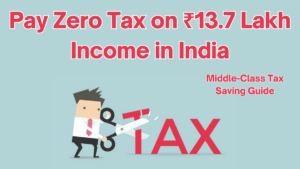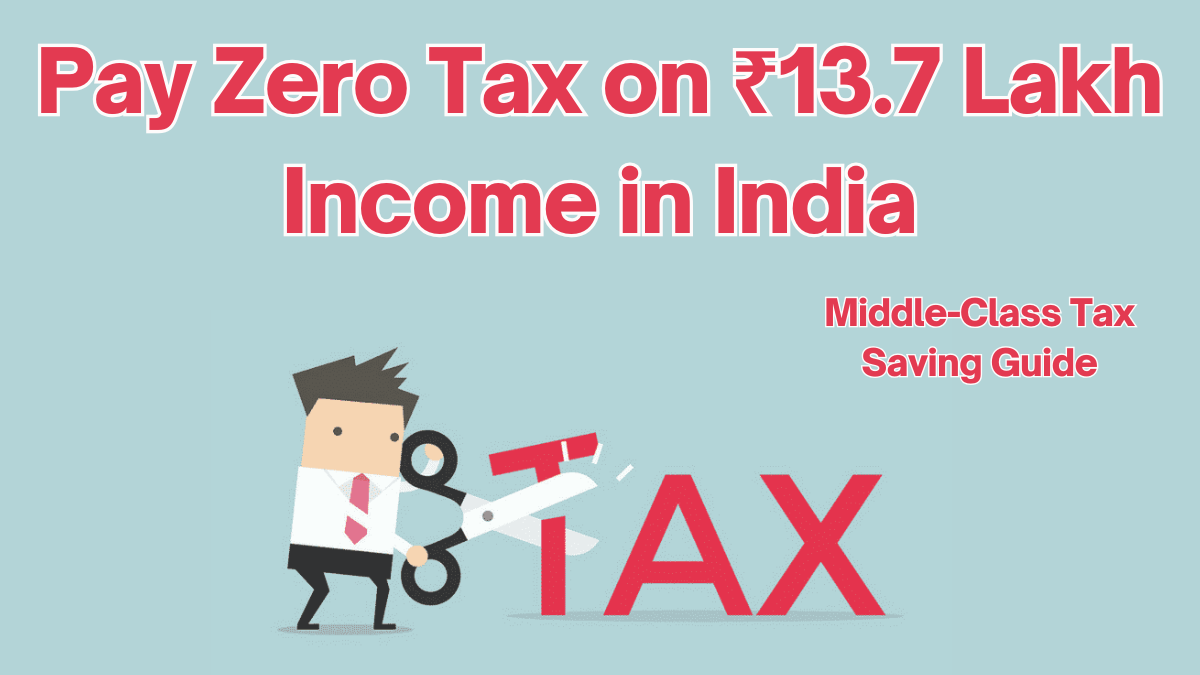With the tax season around the corner, middle-class taxpayers in India are looking for ways to reduce their tax burden and maximize their savings. Fortunately, the Indian tax system offers several exemptions and deductions that can significantly reduce taxable income, allowing individuals to pay little to no tax on their earnings. In this article, we’ll provide useful tax-saving tips and explain how you can save taxes on an income of up to ₹13.7 lakh.

Key Tax-Saving Strategies for the Middle Class
The government has provided various avenues for taxpayers to reduce their taxable income through exemptions and deductions. By understanding and using these options correctly, you can drastically reduce the amount of tax you need to pay.
1. Use of Section 80C Deductions
Section 80C of the Income Tax Act offers some of the most popular tax-saving instruments available to the middle class. The maximum deduction limit under this section is ₹1.5 lakh per financial year. Common investments and expenses that qualify under Section 80C include:
- Employee Provident Fund (EPF): Contributions made towards EPF are eligible for deductions under 80C.
- Public Provident Fund (PPF): Contributions to PPF also qualify for deductions up to ₹1.5 lakh.
- National Savings Certificate (NSC): Investment in NSC can help save taxes.
- Life Insurance Premiums: Payments for premiums of life insurance policies are eligible for deductions.
- Tax-saving Fixed Deposits: Fixed deposits with a lock-in period of 5 years qualify under Section 80C.
2. Health Insurance Premiums under Section 80D
One of the easiest ways to save taxes is by investing in health insurance policies for yourself and your family. Under Section 80D, you can claim a deduction for premiums paid towards:
- Health insurance for self, spouse, and children: A deduction of up to ₹25,000 is available for premiums paid.
- Health insurance for senior citizens (parents): If your parents are senior citizens (above 60 years), the deduction increases to ₹50,000.
This allows you to save taxes while securing your family’s health.
3. Interest on Home Loan under Section 24(b)
If you have a home loan, you can claim a deduction of up to ₹2 lakh per year under Section 24(b) on the interest paid towards the loan. This deduction is available for both self-occupied and rented properties. If you own multiple properties, this deduction can be availed for each one, thereby reducing your overall taxable income.
4. National Pension Scheme (NPS) under Section 80CCD(1B)
Investing in the National Pension Scheme (NPS) is another way to save on taxes. Under Section 80CCD(1B), an additional ₹50,000 can be claimed as a tax deduction. This is over and above the ₹1.5 lakh limit of Section 80C, making it a great way to save additional taxes. The NPS is an attractive long-term investment vehicle that offers the benefit of both tax saving and retirement planning.
5. Standard Deduction of ₹50,000
Salaried individuals and pensioners are eligible for a standard deduction of ₹50,000. This amount is deducted from the total income, reducing the taxable income. It is a simple, straightforward benefit that reduces your overall tax liability.
6. Tax-Free Allowances
Taxpayers can avail of several tax-free allowances that can reduce taxable income. Some common allowances include:
- House Rent Allowance (HRA): If you live in rented accommodation, you can claim tax exemptions on HRA. The exemption depends on factors such as salary, rent paid, and city of residence.
- Leave Travel Allowance (LTA): If you receive LTA as part of your salary, it can be exempt from taxes for travel within India, subject to certain conditions.
7. Capital Gains Tax Exemption through Investments
If you invest in long-term capital assets like stocks, bonds, or mutual funds, the government allows you to earn capital gains that are tax-free if they are held for more than a year. This applies to equity mutual funds and stocks where long-term capital gains (LTCG) of up to ₹1 lakh are tax-free. This strategy can help you save significantly on taxes by making well-planned investments.
How to Save Taxes and Pay 0 Tax on an Income of ₹13.7 Lakh
Now that you know the various tax-saving instruments, let’s calculate how you can pay 0 tax on an income of ₹13.7 lakh. Below is a step-by-step breakdown of how tax-saving deductions can bring your taxable income down to zero.
Calculation of Taxable Income
| Income | Amount (₹) |
|---|---|
| Gross Income | ₹13,70,000 |
| Deductions under Section 80C | ₹1,50,000 |
| Deductions under Section 80D | ₹25,000 |
| Home Loan Interest (Section 24) | ₹2,00,000 |
| NPS Investment (Section 80CCD) | ₹50,000 |
| Standard Deduction | ₹50,000 |
| Total Deductions | ₹4,75,000 |
| Net Taxable Income | ₹8,95,000 |
Tax Calculation on ₹8,95,000 (After Deductions)
| Income Range | Tax Rate | Tax Payable |
|---|---|---|
| ₹0 – ₹2,50,000 | 0% | ₹0 |
| ₹2,50,001 – ₹5,00,000 | 5% | ₹12,500 |
| ₹5,00,001 – ₹8,95,000 | 20% | ₹69,000 |
| Total Tax | ₹81,500 |
With proper deductions, the taxable income reduces, and with the correct use of exemptions and deductions, you will pay only ₹81,500 in taxes. If you plan further investments or optimize your deductions, you can lower your tax liability even further.
Conclusion
Middle-class individuals in India can take advantage of a range of tax-saving instruments and exemptions to minimize their tax burden. With careful planning and the right investments, it’s possible to reduce taxable income significantly and even pay no tax on earnings up to ₹13.7 lakh. Use the above tips to make the most of the available tax-saving options and save your hard-earned money for the future.
People May Ask
1. Can I combine Section 80C and 80D deductions?
Yes, you can claim deductions under both Section 80C and 80D, as they are separate sections, with Section 80C offering a maximum deduction of ₹1.5 lakh and Section 80D allowing deductions for health insurance premiums.
2. What if I don’t utilize the full ₹1.5 lakh limit under Section 80C?
If you do not fully utilize the ₹1.5 lakh limit, you will lose the opportunity to claim it, as the deduction is a fixed amount. It’s best to maximize contributions to eligible investments.
3. Can I claim tax benefits on multiple home loans?
Yes, you can claim tax deductions on the interest paid for more than one home loan, under Section 24(b), as long as the properties are self-occupied or rented.
4. What is the benefit of investing in NPS?
NPS offers an additional tax deduction of ₹50,000 under Section 80CCD(1B), on top of the ₹1.5 lakh limit of Section 80C, making it an excellent tax-saving instrument for retirement planning.
5. Are HRA exemptions applicable if I live in my own house?
No, HRA exemptions are only applicable if you live in rented accommodation. If you live in your own house, you cannot claim HRA exemptions.
Click here to learn more.
Pari is a passionate writer known for captivating stories that blend imagination and reality. Inspired by travel, history, and everyday moments, Pari crafts narratives that resonate deeply with readers.

